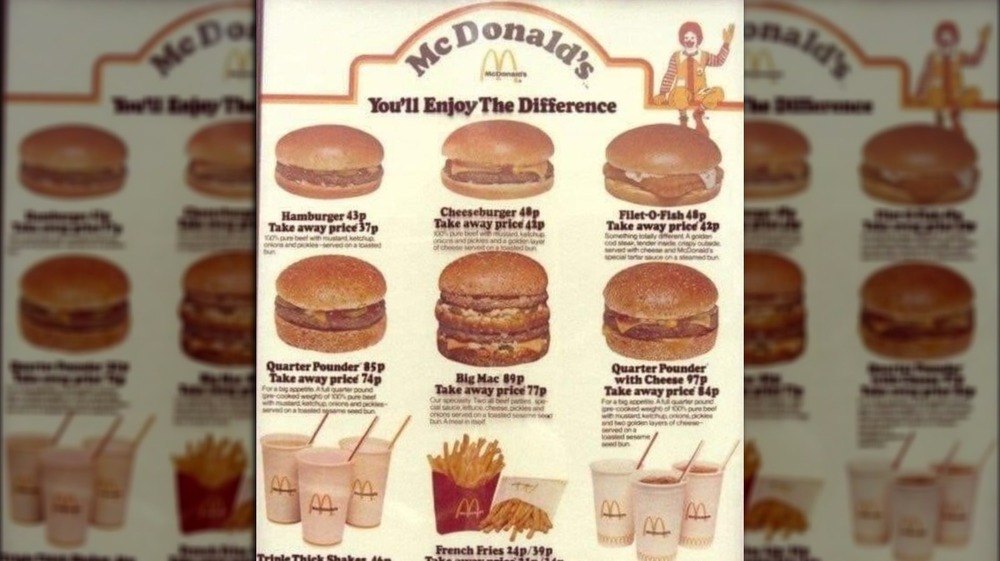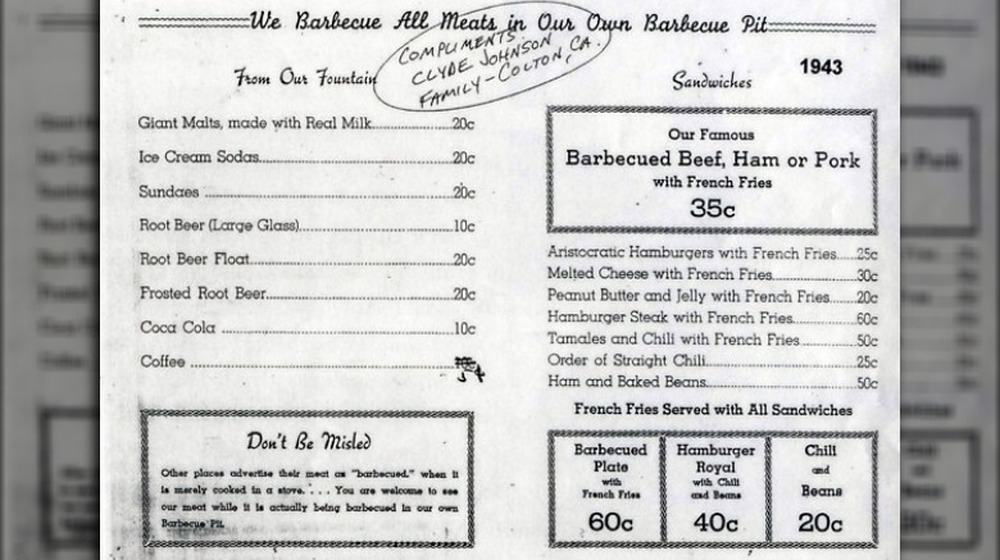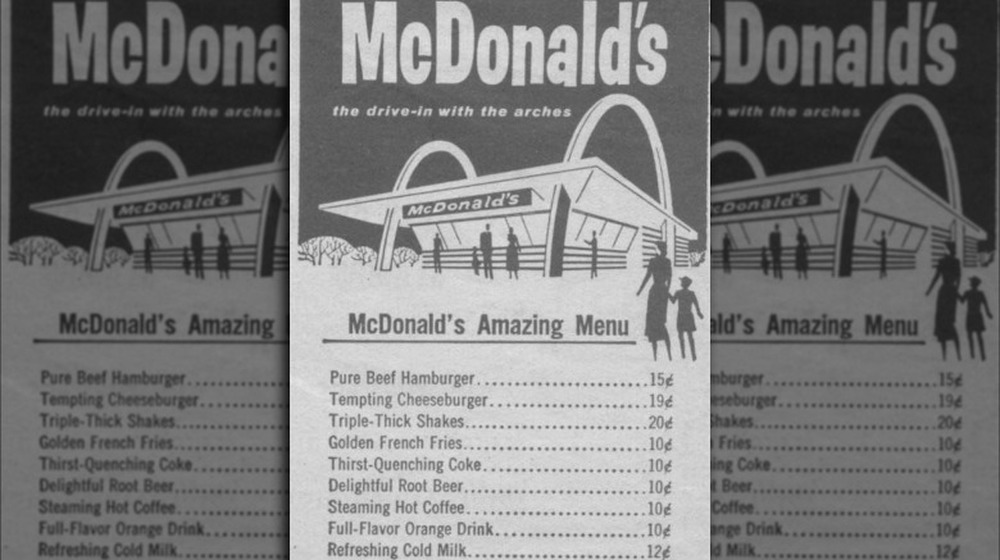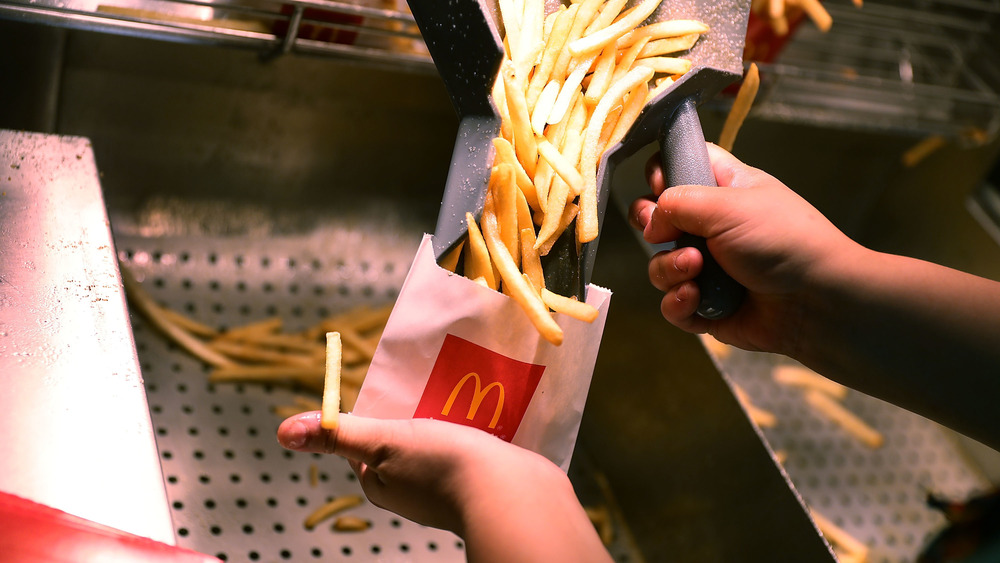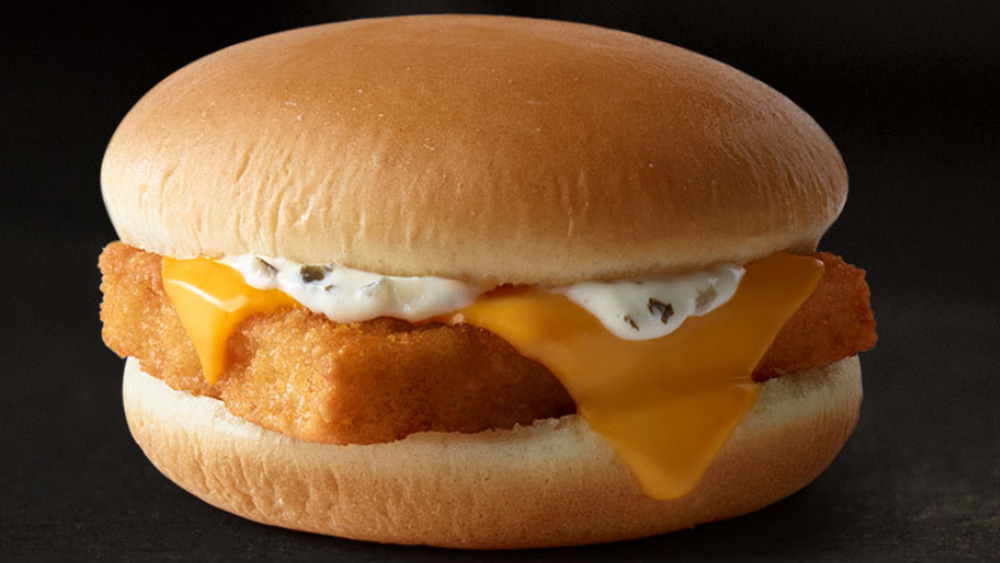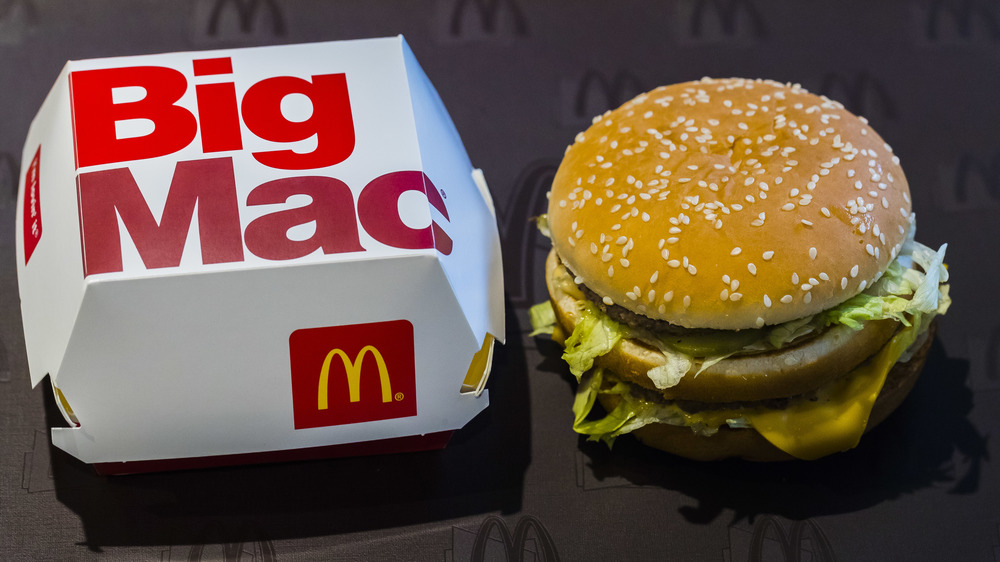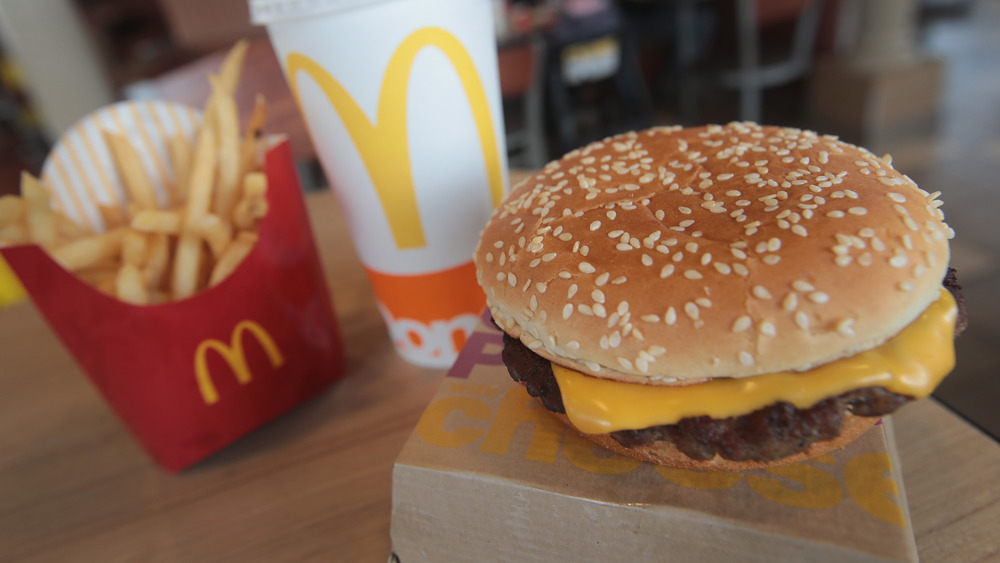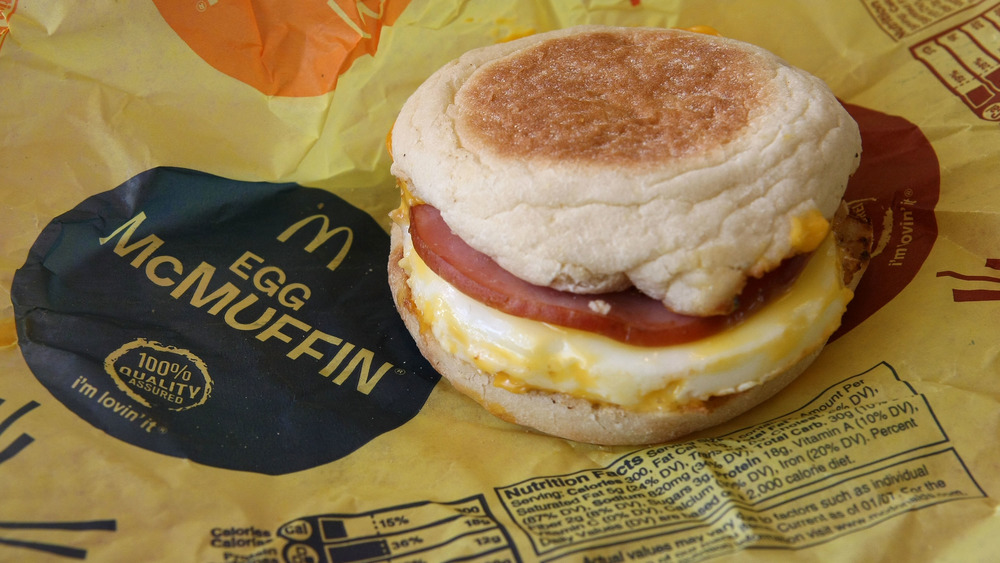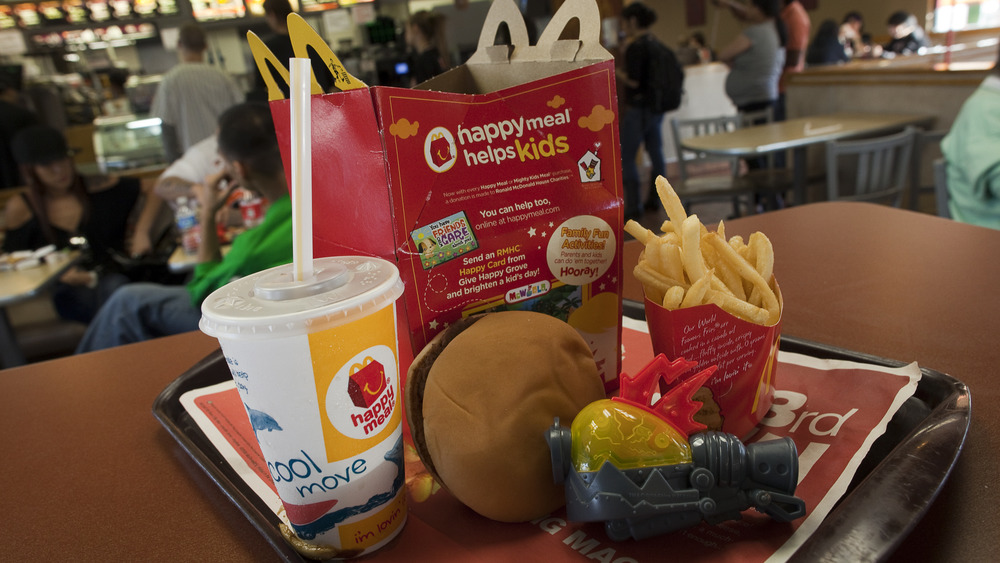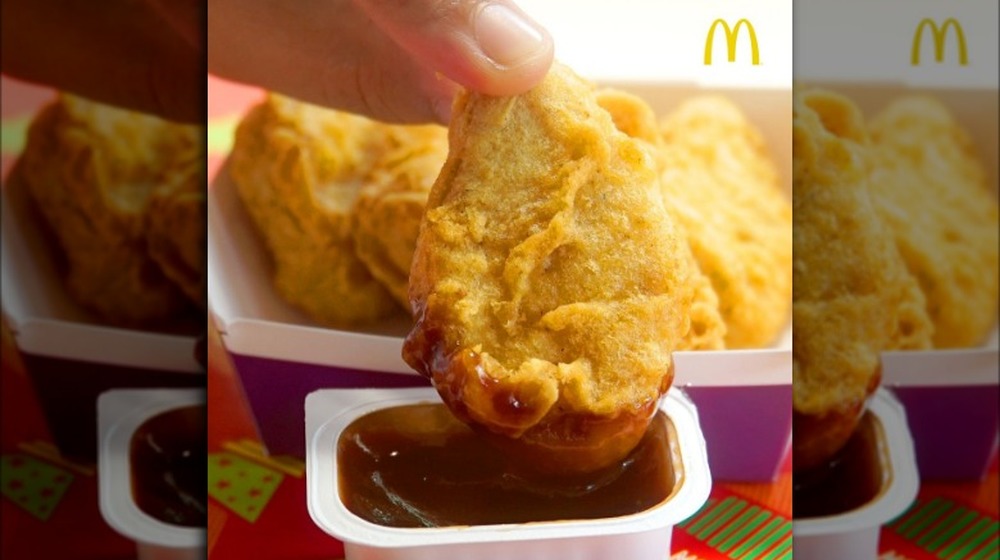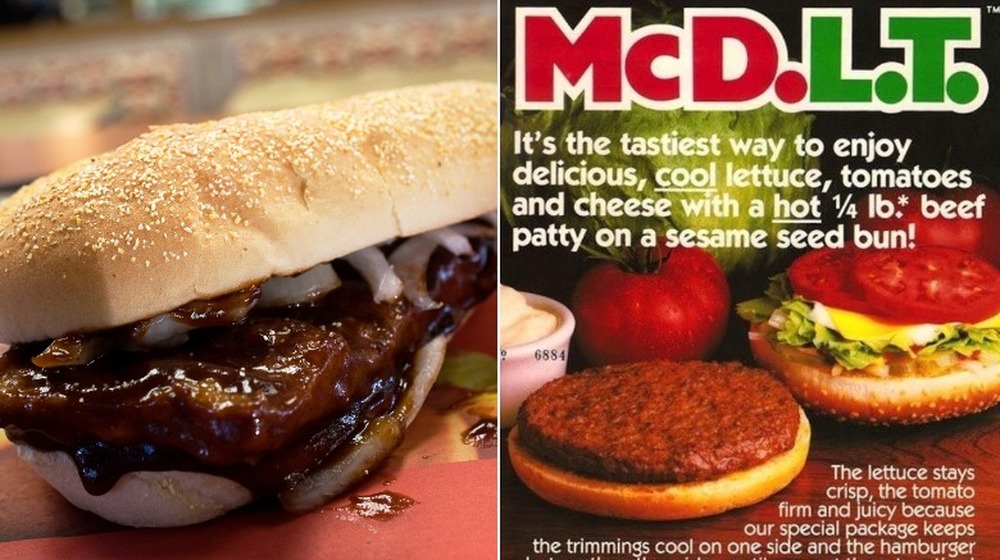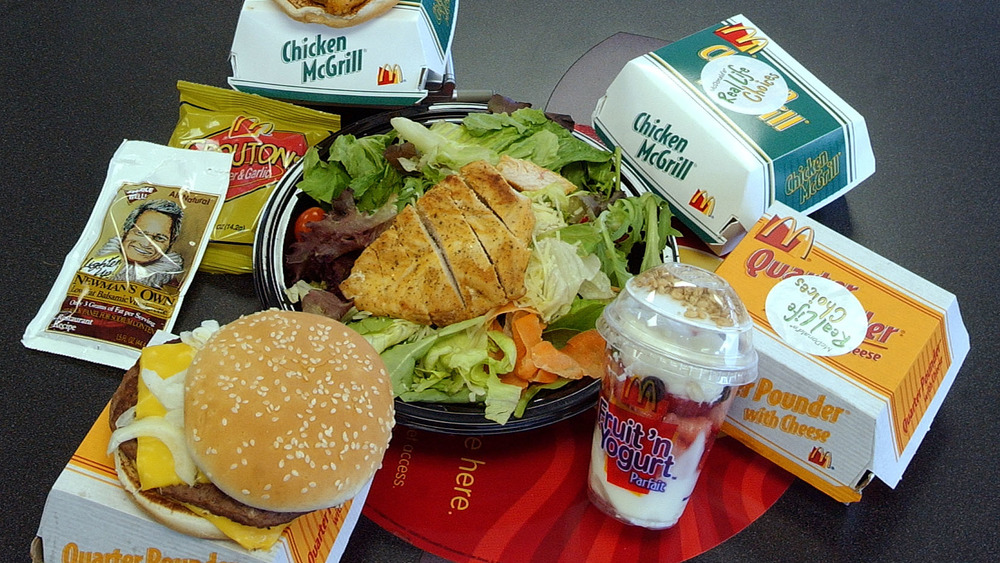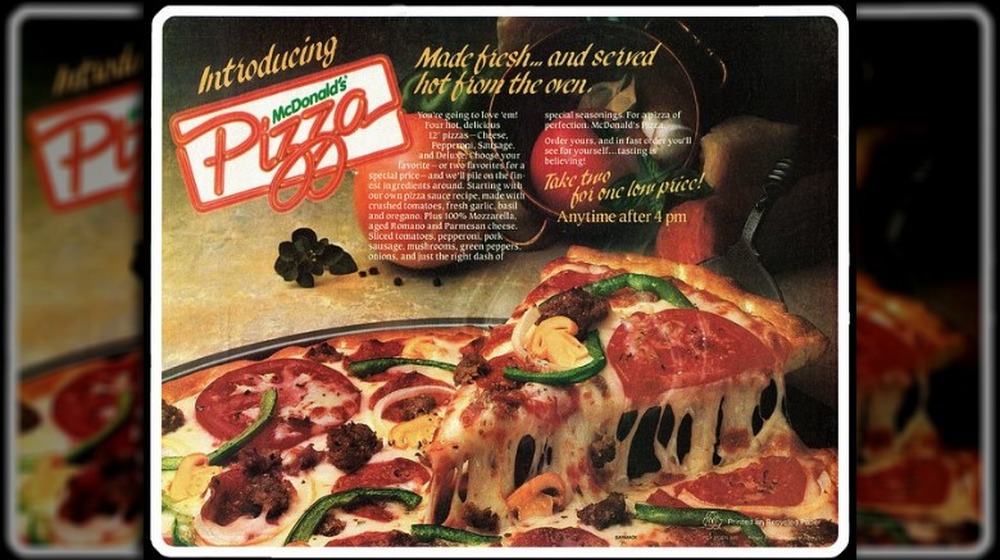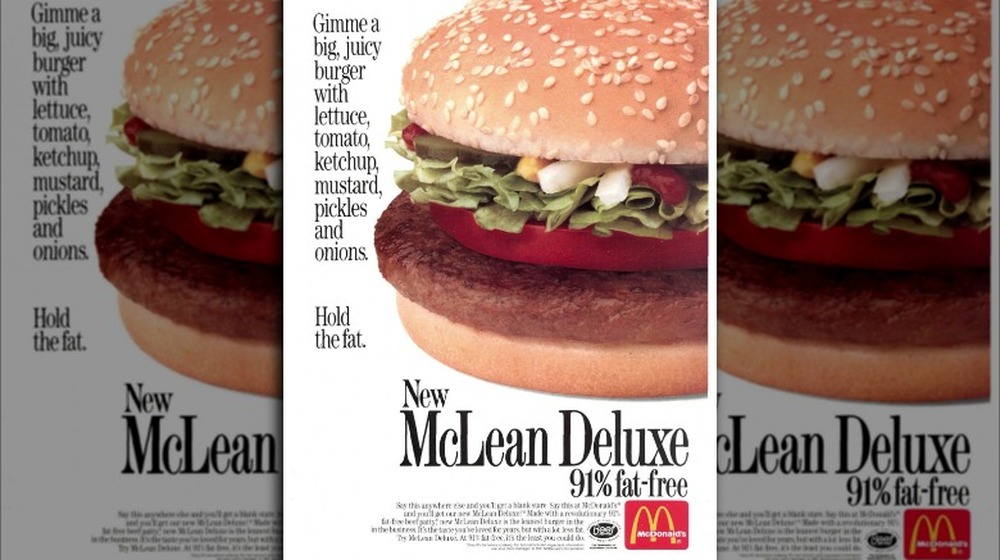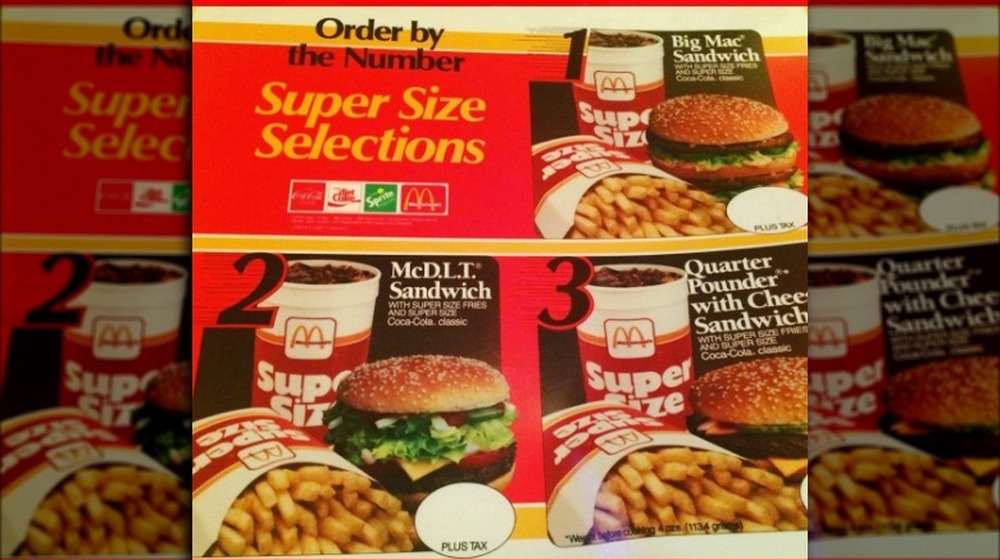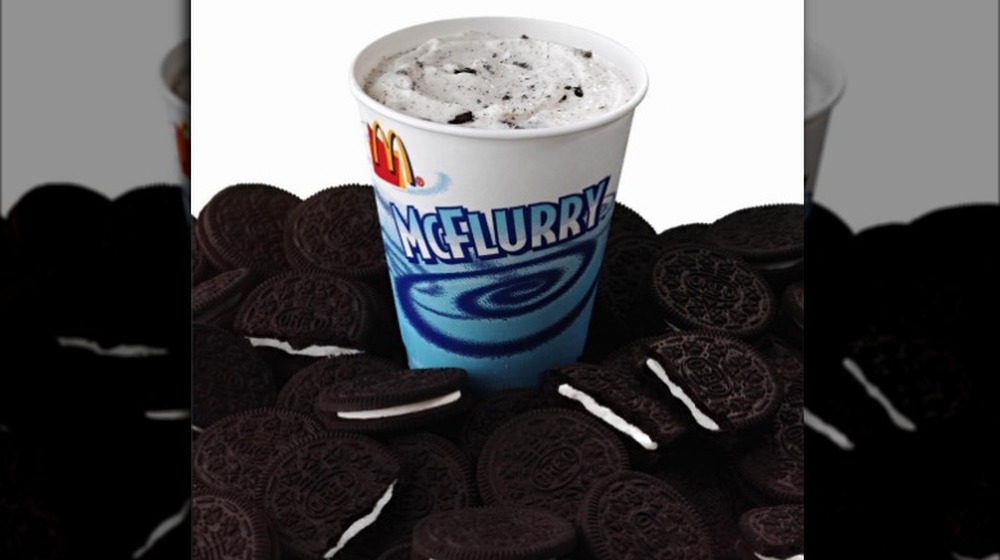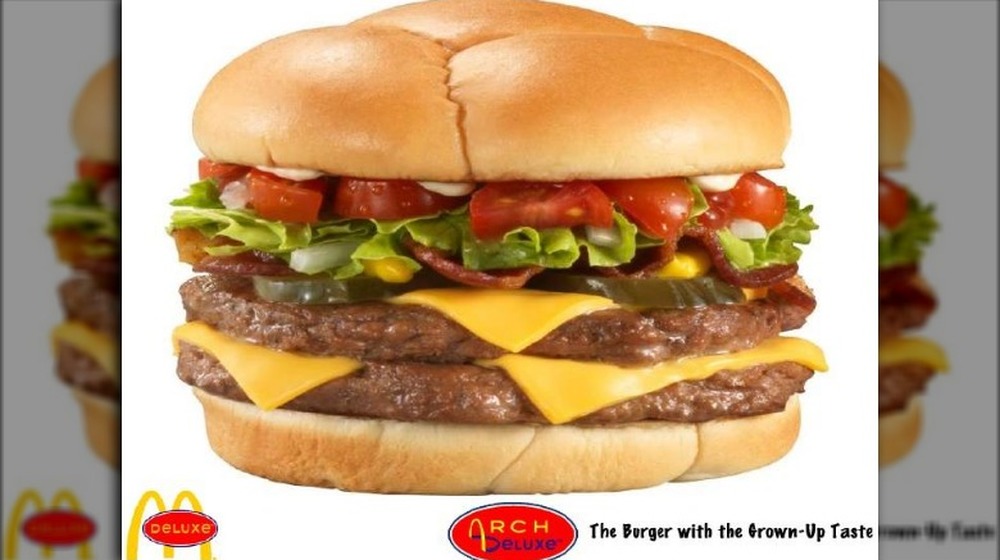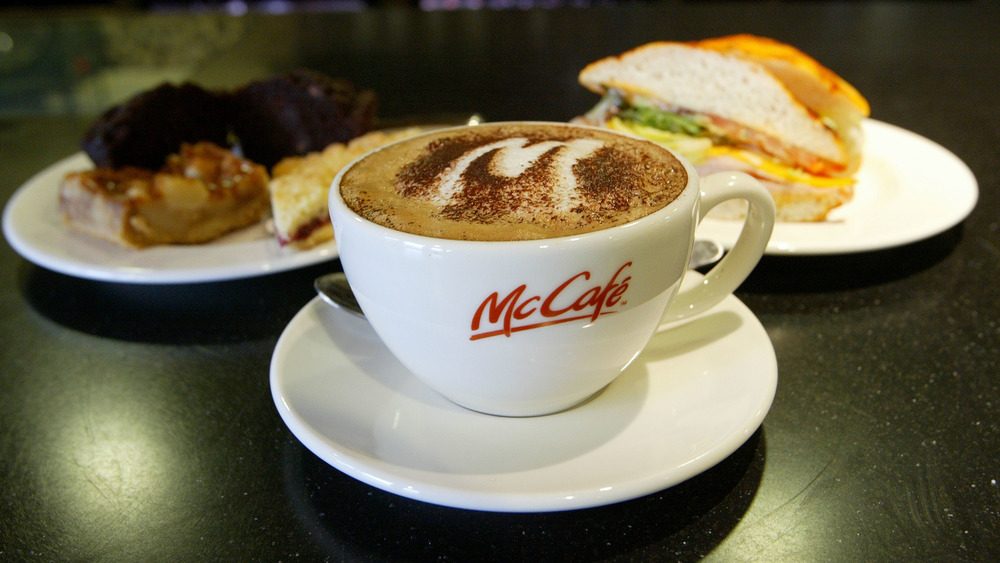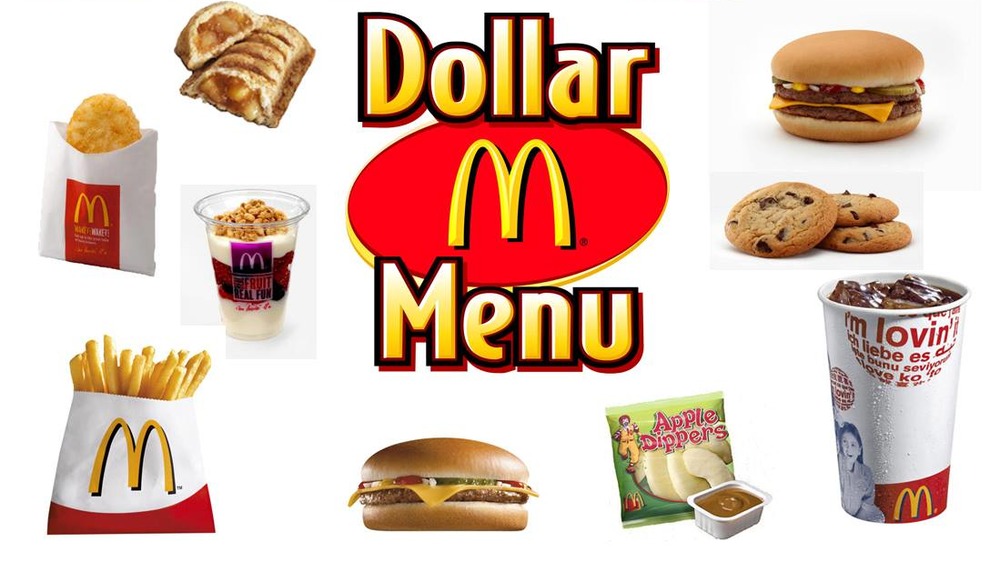What McDonald's Menu Looked Like The Year You Were Born
With nearly 40,000 locations around the world, a globally recognized brand, and revenue in the billions, McDonald's isn't just the king of fast food — it's one of the most successful companies in existence. But all great success stories have to start somewhere, and believe it or not, the McDonald's origin story does not start with hamburgers.
Some eight decades ago, the McDonald brothers opened their restaurant with a very different vision than what it would eventually become. As times changed, the McDonald's menu changed with it. The menu's evolution included the addition of plenty of new items as well as the introduction of breakfast food, desserts, coffee, and value meals.
Not all of McDonald's menu milestones were victories. The company has suffered some notable misses with new items that completely flopped. Yet through it all, McDonald's has remained atop the fast food world. So, what did the McDonald's menu look like the year you were born?
1940-1947: The first McDonald's has a barbecue-focused menu
Brothers Maurice and Richard McDonald opened the first McDonald's on the corner of 14th and North E Streets in San Bernardino, California, on May 15, 1940. But this restaurant looked nothing like the ones we've come to know today. It had no indoor seating, only a few stools at an outside counter. Most customers would just pull their cars into the parking lot and have their food served to them by carhops.
But the most notable difference between that first McDonald's and what the chain would eventually become was its early focus on barbecue — hamburgers were more of an afterthought. Instead of quickly cooking beef patties, the brothers would slow-cook meat for hours in a barbecue pit filled with hickory chips that they imported all the way from Arkansas.
Whatever they were doing was working. The barbecue stand quickly gained popularity, with annual sales topping $200,000.
1948: The original McDonald's reopens with refined menu
Although the first McDonald's location was proving to be successful, much to the brothers' surprise, it was not because of the barbecue. Instead, hamburgers were accounting for 80 percent of the restaurant's sales. "The more we hammered away at the barbecue business, the more hamburgers we sold," Richard McDonald recalled.
The brothers shut the restaurant down for three months in 1948 and completely overhauled the business model. When it reopened, McDonald's had become a self-service eatery. Most importantly, it pared down its menu to just hamburgers, cheeseburgers, soft drinks, milk, coffee, potato chips, and a slice of pie. The hamburger cost just 15 cents.
Not only was the menu a noticeable change, but McDonald's was revolutionizing the food service industry. Its entire operation was now based on speed, consistency, and keeping costs and prices as low as possible. Inspired by Henry Ford and automobile manufacturing, McDonald's implemented an assembly-line production of hamburgers. This ensured that each hamburger was made exactly the same and could be delivered to customers without any wait. This low-cost, high-volume business model is still a hallmark of McDonald's today.
1949-1961: The addition of French fries helps boost McDonald's popularity
It's difficult to imagine McDonald's not offering French fries. After all, it serves nine million pounds of fries each day, making them the restaurant's most popular item.
But believe it or not, French fries weren't always on the menu, even after McDonald's switched from barbecue to burgers. The restaurant was struggling when it first reopened in 1948. Once the McDonald brothers swapped out potato chips for French fries, however, sales went up, and the rest is history. (Not to be forgotten, the restaurant also introduced its triple-thick milkshakes at this time.)
McDonald's French fries haven't been completely without controversy. Up until the 1990s, the fries were cooked in beef tallow, which is high in cholesterol. After some public uproar, McDonald's switched to vegetable oil. In 2008, the company announced it would only use canola oil for frying, in order to remove trans fats from its foods.
1962-1966: McDonald's introduces a non-beef sandwich
The McDonald's corporation owes a great deal of its success to its franchising business model. After all, it has around 14,000 locations in the United States, 90 percent of which are owned and operated by independent franchisees. But franchisees have contributed to far more than just the bottom line. These independent business owners created many, if not most, of the famous fast food restaurant's iconic menu items. That trend started with the Filet-O-Fish.
In 1959, Lou Groen opened the first McDonald's in the Cincinnati area, specifically in Monfort Heights. There was one problem with owning a hamburger restaurant in this neighborhood — the population was 87-percent Catholic. The Catholic Church states that all adults should abstain from eating meat on Fridays during Lent. And back in the early years of Groen's business, Catholics would avoid meat on all Fridays throughout the year.
To stay afloat, Groen devised a new fish sandwich to sell. He took the idea to McDonald's chief Ray Kroc, who had his own meatless menu idea: a slice of pineapple on a bun called the Hula Burger. Kroc agreed to put both on the menu and see which sold best. The Filet-O-Fish won overwhelmingly.
The Filet-O-Fish eventually made it to the nationwide menu in 1965, although it consisted of Atlantic cod instead of Groen's original recipe that used halibut. As of 2007, McDonald's was selling 300 million fish sandwiches a year.
1967-1972: The Big Mac becomes a menu staple
The McDonald's menu took on a significant addition in the late 1960s when its signature item, the Big Mac, was rolled out across the country. It, too, was the product of an inventive franchise owner.
Jim Delligatti opened his first McDonald's restaurant in Pittsburgh in 1957 and was operating a dozen stores in the area by the 1960s. However, the restaurants were suffering from low sales volumes. To fix this, Delligatti thought he needed to add to the menu in hopes that it would broaden the customer base.
Delligatti had previously managed a Big Boy drive-in chain that had a double-decker sandwich on its menu. When it came time to add to his McDonald's menu, he created his own riff on this by combining two beef patties, lettuce, cheese, pickles, and onions on a bun. The final ingredient was a secret sauce that to this day remains a secret (although it's widely thought to be a take on Thousand Island dressing). At first, the new sandwich was sold only at one of Delligatti's stores, then all of them, and then in other test markets. After its continued success, it was eventually given nationwide distribution.
Aside from its taste, the burger has been aided by some successful marketing, including an unforgettable commercial jingle and its "Big Mac" name, which was created by a McDonald's advertising secretary. The restaurant chain estimated in 2007 that it was selling approximately 550 million Big Macs in the United States each year.
1973-1974: The Quarter Pounder is the newest major item on the McDonald's menu
The Quarter Pounder trails only the Big Mac on the list of McDonald's most iconic burgers. So famous is it that it found its way into one of the most famous bits of dialogue in recent movie history.
McDonald's released the new Quarter Pounder burger nationwide beginning in 1973. It was invented by Al Bernardin, a McDonald's corporate employee who eventually rose to become head of the McDonald's training center, Hamburger University. But his most notable contribution came after he left headquarters to open a McDonald's franchise in Freemont, California. Wanting to satiate customers looking for, as he said, "a higher ratio of meat to bun," Bernardin came up with a more substantial burger.
Debate has always surrounded whether the burger is, in fact, four ounces in weight. The answer is yes ... when the beef patty is frozen. When it cooks on the grill, it shrinks to less than three ounces. However, in 2015, McDonald's upped the weight of the frozen patty to 4.25 ounces.
1975-1978: McDonald's makes gains in the breakfast market thanks to the Egg McMuffin
Yet another franchisee-created menu item came about in the mid-1970s with the introduction of the Egg McMuffin. This breakfast staple was the brainchild of Herb Peterson, who owned a McDonald's in Santa Barbara, California. Peterson believed McDonald's could be a successful morning-hours restaurant but didn't think people wanted to eat burgers for breakfast. A fan of eggs Benedict, Peterson experimented with a sandwich version of the dish. Eschewing hollandaise sauce because of its messiness, Peterson placed butter and cheese on top of an egg, along with Canadian bacon, all in between an English muffin.
The most difficult part of getting the Egg McMuffin into restaurants was convincing Ray Kroc. In his autobiography, Grinding it Out: The Making of McDonald's, Kroc admitted that he originally thought the breakfast sandwich was a "crazy idea ... But then I tasted it, and I was sold. Wow!"
Not only was the Egg McMuffin another popular menu item, but it opened a whole new market for McDonald's. According to Time, by 1981, breakfast accounted for nearly 20 percent of the restaurant's sales.
1979: The Happy Meal is rolled out
In the late 1970s, a McDonald's St. Louis regional advertising manager by the name of Dick Brams suggested an idea that likely did not seem revolutionary at the time — creating a meal just for kids. In 1979, it came to fruition when a circus-wagon-themed Happy Meal was served. It had most of the same components you'll find today: a hamburger or cheeseburger, French fries, cookies, and a soft drink.
The final, and most important Happy Meal ingredient is the toy. Back then, lucky kids received a stencil, wallet, ID bracelet, puzzle lock, spinning top, or McDonaldland-character eraser. Nowadays, the toys change nearly every week. Over the years, they have included Transformers, Hello Kitty, Legos, Teletubbies, and G.I. Joe. The most notable upgrade occurred in 1987, when Disney character toys first appeared.
As consumers have become more health-conscious, parents have been wary of the food found in Happy Meals. To alleviate concerns, McDonald's began offering one-percent milk, apple slices, and juice boxes in the early 2000s. Four- and six-piece Chicken McNuggets are also available in lieu of a burger.
1980-1984: Chicken McNuggets take center stage
Up until the late 1970s, McDonald's was humming along as an ever-growing fast food empire. But then they faced a very difficult challenge: a shift in consumer behavior. It was during this time that the government was recommending people eat less red meat due to its high fat and cholesterol content. McDonald's had non-beef options but was still a burger joint at heart.
Wanting to keep the customers who were eating less beef, the restaurant looked to chicken for help. Their first few ideas, including fried chicken and a deep-fried chicken pot pie, failed. Eventually, they decided to simplify the dish by cutting the chicken into chunks, battering it, and throwing it in the fryer. Just five months later, in 1980, McDonald's served its first Chicken McNuggets in Knoxville, Tennessee.
It would take a few years for the company to build out their restaurants' infrastructures to be able to make the countless nuggets they would need to, but in 1983, Chicken McNuggets finally became available nationwide.
1985: The McDLT replaces the McRib
The McRib made its way McDonald's menus in the early 1980s. As it turns out, it was the result of the popularity of recently introduced Chicken McNuggets. Consumers were buying so many nuggets that it resulted in a chicken shortage. In order to give diners another option, McDonald's created a pork sandwich.
But the McRib wasn't originally the cult favorite it is today. Just a few years after its debut, it was pulled from menus and replaced with the McDLT, a burger that came with lettuce and tomato. Though this doesn't seem like a revolutionary idea, McDonald's had long resisted adding vegetables to their burgers. It wasn't until they came up with a two-compartment storage box that kept hot and cold ingredients separated that the restaurant relented.
As for the McRib, it made a brief return in 1994. Since then, it has been an elusive bite to find, popping up on the McDonald's menu here and there for a limited time.
1986: McDonald's goes healthy as it begins serving salads
A 1983 study by the National Restaurant Association found that four out of ten consumers had altered their food ordering habits out of nutritional concerns. As consumers became more health-conscious, even the bastion of unhealthiness, fast food, was forced to change its ways ... or at least supplement its menu.
This is where McDonald's found itself in the mid-1980s. And if the restaurant didn't want to bend to consumers' taste, the competition forced its hand. By this time, Wendy's, Burger King, Hardee's, and Roy Rogers all had salad bars. And thus, McDonald's started selling salads. It spurred on even more of a fast food rivalry. At the time, a Burger King spokesperson told The Washington Post, "It's good to finally see McDonald's, which calls itself the leader, following our lead."
It began in 1986 at 1,000 different test locations in six markets before being rolled out across the country. Back then, the three salad offerings were garden, chef's, and shrimp salads.
1986-1991: McDonald's enters the pizza business
By the mid-1980s, McDonald's was bringing in $11 billion in sales per year. That, apparently, was not enough. During this time, the fast food pizza industry was growing rapidly. So despite pizza and hamburgers not necessarily being a natural fit, McDonald's wanted a slice of the pie.
The company's pizza testing started in 1986 and expanded a few years later, and by the 1990s, approximately 40 percent of the McDonald's locations in the United States were serving pizza.
But that's about as far as it got. The product had notable problems that eventually caused it to be quickly removed from the menu. Restaurants needed new equipment to make pizza and had to remodel their kitchens. Furthermore, pizza takes time to cook, so customers had extended wait times. Those in the drive-thru were often asked to park their cars and wait. And then there's the fact that the large pizza box couldn't fit through the drive-thru window.
1991: The McLean becomes McDonald's new healthy menu item
The McDonald's health kick continued into the 1990s as critics continued to rail against fast food restaurants' nutritionally deprived offerings. In 1990, one went as far as penning a newspaper article aimed at the Golden Arches with the headline "Your Hamburgers Have Too Much Fat!"
A year later, McDonald's unveiled the McLean. It contained just nine percent fat by weight, significantly less than the 20 percent most of the restaurant's other burgers had. The McLean had a lot of things going against it, though. Most evident was a lack of flavor. Seasoned water was added to the beef patties to make up for the missing fat, most of which burned off in the cooking. The meat also contained a type of seaweed powder called carregeenan. Although it's a common food additive, rivals jumped on the chance to call out McDonald's for using it.
The McLean dried out quickly, so it had to be made to order, which went completely against McDonald's business model of getting customers in and out as quickly as possible. All this plus the fact that the burger was also McDonald's most expensive led to the McLean having a short shelf life.
1992: The McDonald's menu is Supersized
The McDonald's menu took on a whole new look when the restaurant introduced the "Supersize" option in 1992. It allowed customers to bump up the portion sizes of their fries and drinks for a minimal price increase.
The idea started as a promotion McDonald's did for the film Jurassic Park. For this, the larger sizes weren't "Supersize" but "Dino-size." The marketing tactic worked so well that McDonald's kept it on the menu.
"Would you like to Supersize that?" became a famous phrase, but you won't hear it from McDonald's employees anymore. In 2004, the restaurant chain phased out its signature menu upgrade for the purpose of "menu simplification." But most believe McDonald's caved from public pressure for healthier options. The final blow may have been the release of the documentary Super Size Me, in which the filmmaker's health deteriorates while eating nothing but McDonald's for a month.
1992-1995: New desserts are served across North America
McDonald's added some big hits to its dessert menu in the early 1990s. First came the baked apple pie, introduced in 1992. The restaurant, of course, had already been serving apple pie going back as far as the 1960s. But these pies were fried. Over the years, consumers had become more and more health-conscious, so fried food started to wane in popularity. So McDonald's updated the apple pie by baking it instead. Nowadays, the pies are filled with six different types of apples: Fuji, Golden Delicious, Jonagold, Rome, Gala, and Ida Red.
A few years later, a creative franchise owner in Canada named Ron McLellan came up with what would prove to be McDonald's signature dessert: the McFlurry. The first frozen treat, a concoction of soft serve ice cream mixed with candy, was served at McLellan's restaurant in Bathurst, New Brunswick. It has since spread to menus around the world.
1996-2000: McDonald's tries to attract more adult customers with the Arch Deluxe
History shows that over the decades, McDonald's has gone back and forth trying to attract older and younger customers. One notable attempt at the former was the Arch Deluxe. It did not go as planned.
In an attempt to appeal to more adults, the restaurant created the Arch Deluxe, a more expensive burger, which was a quarter pound of beef, bacon, lettuce, tomato, cheese, onions, ketchup, and secret sauce. McDonald's has always been known for its cheap, quick food, so trying to go for a more sophisticated look did not work. Sales of the burger disappointed, a fact that, on its own, may not have been a disaster. But McDonald's spent $150 million and created a huge marketing campaign to promote its new product.
The Arch Deluxe was phased out in 1998 and 1999 and was gone from menus completely by 2000.
2001: McCafe arrives in the United States
McDonald's opened a new type of store to kick off the 21st century. The first domestic McCafe, located in Chicago, came to the United States in 2001 after first being introduced in Australia in 1993. It was supposed to be more upscale than a typical fast food outlet, with leather couches, bistro-style tables, and food served on fine china with stainless steel flatware.
Although all McCafes were located within or adjacent to traditional McDonald's restaurants, the menu was significantly different. As the name implies, its offerings included gourmet coffees, teas, pastries, and desserts: more specifically, items like cappuccino, lattes, and chocolate caramel peanut pie.
Brick-and-mortar McCafe locations didn't last long, but since 2009, McCafe food and beverage items have become fully integrated into the traditional McDonald's menu. Even better, McCafe coffee is available at retailers nationwide in whole-bean, ground, and single-serve varieties.
2002: The Dollar Menu arrives
It did not take long into the 21st century for McDonald's to modernize its menu pricing with a entire new category: the Dollar Menu.
Beginning in 2002, McDonald's offered several different items for just $1 each. These included a McChicken sandwich, McValue fries, a small or medium soft drink, a Fruit 'n Yogurt Parfait, a side salad, two baked apple pies, a sundae, and the restaurant's newest burger at the time, the Big N' Tasty.
The idea behind the Dollar Menu was to lure customers in with extremely inexpensive food and then try to upsell them with other items in hopes of getting them to spend more. The strategy only half-worked. The people came, but they didn't spend — at least not enough for the menu to work. During the first month of the Dollar Menu's existence, the chain's average check total actually fell three cents in value.
Over the years, the Dollar Menu has evolved (or devolved) into various value menus, including the "Dollar Menu & More" and the "McPick 2." Today it's the "$1 $2 $3 Dollar Menu."
